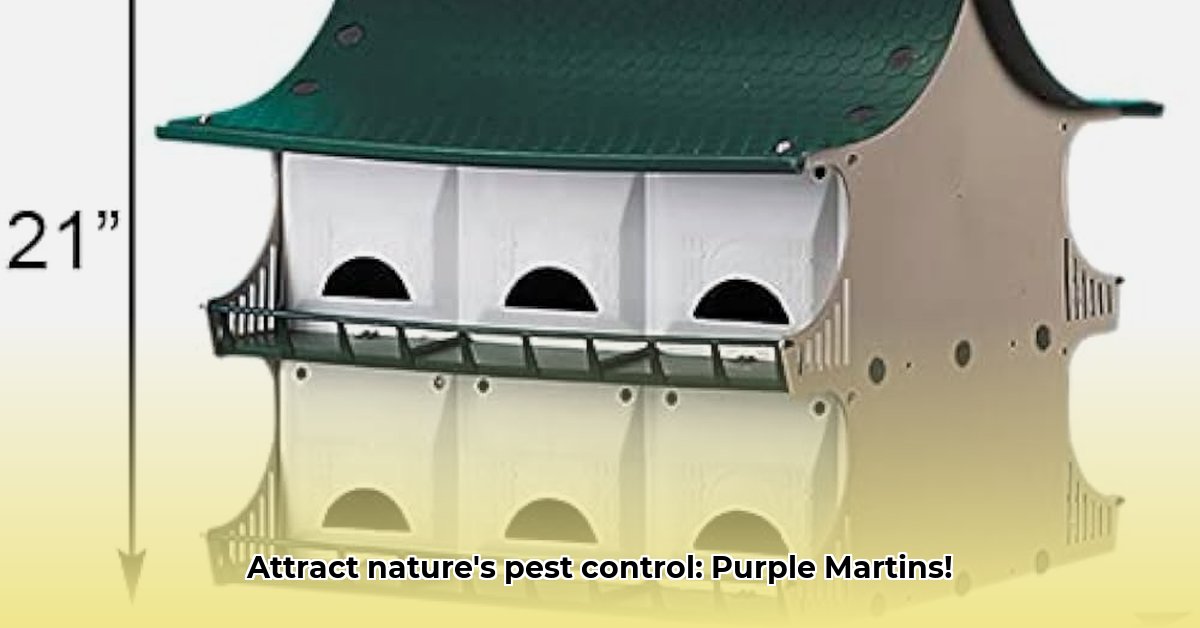
Choosing the Right Purple Martin House at Tractor Supply
Considering a natural approach to pest control? Purple martin houses offer an environmentally friendly solution, and Tractor Supply offers a variety of options. Selecting the right house is crucial for attracting these beneficial birds and maximizing pest control. But how do you choose the best house for your needs? For more information on Tractor Supply's offerings, see their helpful guide here.
Key Considerations:
- Size: Larger houses accommodate more birds, leading to greater pest reduction. A larger colony means more insects consumed.
- Material: Durable materials like high-quality wood or metal resist weathering and damage, ensuring a longer lifespan for your investment.
- Predator Protection: Features like predator guards are essential to protect nests from raccoons, snakes, or other predators. Consider models with baffles or enclosed entrances.
- Starling Resistance: House sparrows and European starlings compete with Purple Martins for nesting space. Choose houses designed with features to deter these invasive species. This could involve specialized entry holes or other design elements.
Don't forget to check the Tractor Supply website for images and detailed specifications of available models. Careful selection ensures a successful nesting season and effective pest control.
Setting Up Your Martin "Hotel": Optimal Placement for Maximum Effectiveness
Strategic placement is crucial for attracting Purple Martins and maximizing their pest-control benefits. Where you place the house greatly influences the birds’ success and your ability to reduce pest populations.
Placement Guidelines:
- Height: Mount houses 12-15 feet high to deter ground predators. Higher placement provides safety and reduces accessibility for predators.
- Visibility: Select an open location with good visibility, away from dense trees or obstacles that impede flight paths. Clear approaches are key for their landings.
- Proximity to Water: Place the house near a water source, such as a pond or birdbath, to provide a convenient water supply for the birds and their young. Hydration is important.
- Shelter: Provide some protection from harsh weather. While open spaces are preferred, a little shelter from intense sun or heavy rain can be beneficial.
- Open Space: Ensure surrounding areas have enough open space for easy take-off and landing. Avoid obstructions near the entrance.
Installation and Ongoing Maintenance: A Step-by-Step Guide
Installing your purple martin house is straightforward. Following these steps will ensure a safe and secure structure for the birds:
- Secure Mounting: Use strong mounting hardware appropriate for the house and mounting surface. The stability of the house is crucial, particularly in windy conditions.
- Cleaning: Thoroughly clean the houses annually after the breeding season (typically late summer/early fall). Remove old nests and debris to prevent disease.
- Repairs: Promptly repair any damage to maintain the structural integrity and protection of the house. Regular inspections help identify and address problems.
Monitoring Your Martin Colony and Evaluating Their Effectiveness
Monitoring your martin colony helps assess their impact on pest populations. Regular observation provides valuable data and insights into the colony's success and its contribution to pest control.
- Population Counts: Track the number of nesting pairs and young birds produced annually. This provides an indicator of colony health and success.
- Pest Observation: Note any changes in pest populations in your fields following the establishment of the martin colony. Reduction in pest numbers is a direct benefit of having the birds.
While purple martins primarily consume flying insects, their effectiveness varies depending on the target pest species and the season. They don't eliminate all pests, but contribute to a reduction in numbers. Combining martin houses with other IPM strategies enhances overall effectiveness.
Potential Limitations and Realistic Expectations
Remember, purple martin houses aren't a magic bullet. Consider these limitations:
- Seasonal Limitations: Martins migrate, providing pest control only during their nesting season (typically spring and summer). Their absence during other seasons must be anticipated.
- Nest Predation: Predators can target nests, impacting colony size and success. Proper house selection and placement mitigate this risk.
- Disease: Diseases can affect martin populations, reducing effectiveness. Regular cleaning and maintenance are essential for disease prevention.
Combining with Other Integrated Pest Management (IPM) Techniques: A Holistic Approach
Using purple martin houses is part of a larger integrated pest management strategy. Complement this natural approach with other ecologically sound techniques:
- Crop Rotation: This helps disrupt pest cycles and reduces reliance on pesticides.
- Beneficial Insects: Introducing beneficial insects that prey on or compete with target pests.
- Targeted Pesticide Applications: Using pesticides only when absolutely necessary and applying them with precision and care.
A multi-faceted approach is most successful in establishing long-term pest management control.
Conclusion: Harnessing Nature's Pest Control
Purple martin houses from Tractor Supply offer a sustainable and environmentally friendly approach to pest control. While they have limitations, their integration into a holistic integrated pest management strategy contributes significantly to a healthier, more productive farm. By following these guidelines, you can effectively leverage the natural pest control services of these beneficial birds.
[1]: Birds Choice Blog: The Loss of Purple Martins. Birds Choice Blog. https://birdschoice.com/blogs/news/purple-martin-houses (Accessed: 2025-02-28)